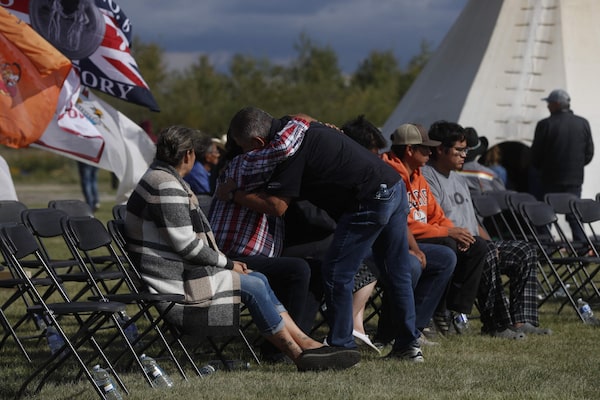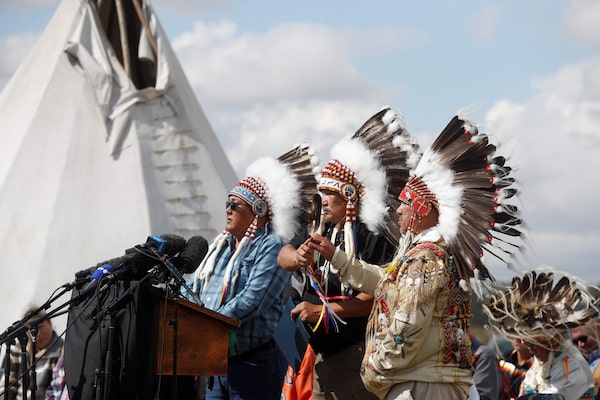
People hug before a press conference by officials at the James Smith Cree Nation on Sept. 8.LARS HAGBERG/AFP/Getty Images
First Nations leaders, the Premier of Saskatchewan and the head of the RCMP publicly addressed the James Smith Cree Nation on Thursday, as the community began moving forward after a stabbing rampage that ended with 12 people dead, including the two murder suspects.
The community members and dignitaries gathered on the reserve, located about 200 kilometres northeast of Saskatoon. Three tipis flanked the speakers, and a sweat lodge and ceremonial fire were nearby.
The previous afternoon, a four-day manhunt for one of the suspects, Myles Sanderson, had ended with his arrest after a high-speed chase on Highway 11. Shortly after, Mr. Sanderson went into “medical distress,” according to RCMP, and was pronounced dead in a Saskatoon hospital. His co-accused and brother, Damien Sanderson, had been found dead on the reserve earlier in the week. Both brothers, and nine of the 10 stabbing victims, were members of the First Nation.
Many of the speakers at Thursday’s event had been personally affected by the killing rampage, and they described a community deep in grief. Community leaders also spoke of the many systemic issues affecting First Nations people and communities in Canada, and the need for systemic changes, including the creation of Indigenous-led policing and justice systems, and the introduction of new resources for mental health and addiction counselling.
Darryl Burns attended the event to honour his sister, Gloria Burns, a member of the James Smith Cree Nation’s community response team. She was killed when she responded alone to a call about the stabbings while they were still unfolding on Sunday morning.

LARS HAGBERG/AFP/Getty Images

From left, Chief Bart Tsannie, Grand Chief Brian Hardlotte and Vice Chief Christopher Jobb.LARS HAGBERG/AFP/Getty Images
Mr. Burns introduced the crowd to Skye Sanderson, Damien Sanderson’s wife.
“Her husband is accused of killing my sister,” he said. He wrapped his right arm around her shoulder as she covered her eyes and cried. “Our family is here to forgive,” he added.
The killings tore at family bonds throughout the small First Nation community. Ms. Sanderson’s father, Christian Head, was one of the victims. Also among the dead is Earl Burns Sr., whose daughter, Vanessa Burns, was Myles Sanderson’s common-law partner and the mother of his five children. And Myles is a suspect in the death of his brother.
At Thursday’s gathering, Mr. Burns urged the crowd to support Ms. Sanderson.
“This woman shouldn’t have to bear that kind of guilt and shame and responsibility,” Mr. Burns said. Friends and family stood up and gathered around both the crying widow and the man begging others to offer her understanding.
After the killings, Ms. Sanderson sat by herself in the community’s gym, Mr. Burns said. He approached her with a message: “I told her part of forgiveness is accepting the forgiveness of our community. Our community wants to forgive her. Now it is up to her to accept that forgiveness from us.”
She nodded and wiped away tears.
While Mr. Burns focused on forgiveness, the other speakers addressed topics ranging from parole reform to Indigenous-led policing. Chief Wally Burns of the James Smith Cree Nation urged the community to turn away from drugs and alcohol.
“These acts of violence have to stop, and they have to stop now,” Chief Burns said. He wore a headdress as he spoke. “We’ve got to protect our community, fight against drugs and alcohol. We all have to come together as a community. As Canadians. As a whole.”
Premier Scott Moe offered condolences and support on behalf of the province. “It is fair to say all of Canada is with you,” he told the crowd. “We are all reaching out to support you and your families.”
Many First Nations chiefs and some of the victims’ family members thanked RCMP for the way they handled the crisis. RCMP Commissioner Brenda Lucki told the crowd the force would support the James Smith Cree Nation as it recovers.
“We will stand by you in healing this community,” she said, noting that the Mounties are increasing their Indigenous recruitment, in an effort to provide self-governed police services. “This can never happen again,” she added.
Myles Sanderson had an extensive criminal record, according to court documents. Earlier this year, he received a statutory release from prison after serving two-thirds of a sentence for a number of offences, including domestic violence. Statutory releases are designed to reintroduce federal offenders slowly into society by placing conditions on them as they reintegrate.
But Mr. Sanderson stopped reporting to his parole officer and police put him on the wanted list this spring.
With a report from Nancy Macdonald
Also read:
Opinion: In this devastating moment, Canada must support the James Smith Cree Nation
Saskatchewan suspect’s case draws new scrutiny to statutory release